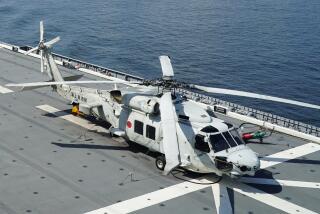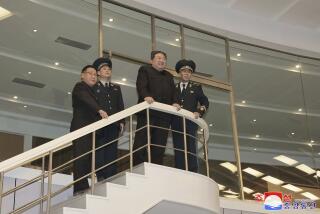Japan Gives Up Chase of Suspected N. Korean Spy Ships
- Share via
TOKYO — Japanese warships firing warning shots and military aircraft dropping explosives chased two suspected spy ships in the Sea of Japan for more than 24 hours but gave up Wednesday when the vessels sped into North Korean territorial waters, the government said.
The two ships were disguised to look like Japanese fishing boats but were bristling with antennas, bore false names, appeared to carry no fishing gear and turned out to be so swift that they quickly outpaced the Japanese coast guard vessels that initially tried to nab them.
Japanese officials declined to confirm media reports that the ships, which were first spotted lurking about 28 miles off the Noto Peninsula on Tuesday, were suspected of being North Korean. Nevertheless, Japan officially requested that North Korea hand over the ships and crew but had received no response as of Wednesday afternoon, Chief Cabinet Secretary Hiromu Nonaka said.
The military action marked the first time Japan has fired warning shots since 1953, when it intercepted a suspected Soviet submarine, and the first use of a 1954 law that allows the prime minister to call out the Self-Defense Forces to counter a naval threat, authorities said.
Without specifically naming North Korea, Defense Agency chief Hosei Norota said two enemy MIG-21 jet fighters had scrambled toward the two ships, and that Japan had called off the chase because “if we went further, it could have begun a war.”
This morning, the ships were reportedly headed toward a North Korean port.
The U.S. government said it was “seriously concerned about the incursion” and that U.S. aircraft had taken part in tracking the ships. Russia, a former North Korean ally, also offered Japan its help in finding the intruders.
Analysts agreed that the incident will further inflame public opinion against North Korea among the Japanese, who are already incensed by the North’s launch in August of a ballistic missile, and make it easier for Prime Minister Keizo Obuchi’s government to push through parliament legislation redefining the scope and specifics of how Japan and the U.S. would cooperate in case of security emergencies in the “area surrounding Japan.”
Some domestic critics faulted the Maritime Safety Agency, which is charged with patrolling Japan’s coast, for failing to capture the ships. Others charged that the government’s decision to fire about 1,200 warning rounds, drop eight bombs and send out destroyers to chase the fleeing vessels was disproportionate to the threat posed by the ships, and questioned the timing of the incident.
“This is good propaganda fodder at a time when the [U.S.-Japan Security Treaty] guidelines are being debated” in parliament, defense analyst Tetsuo Maeda said.
A senior foreign policy official said the ships had been detected by Japanese P-3C surveillance planes and that Japan had shown “much restraint” and taken pains not to antagonize its neighbors by halting the chase once the two ships moved outside Japan’s announced air-defense identification zone and dropped off Japanese radar.
The presence of North Korean spy ships off the coast of Japan is no surprise. The government has publicly accused North Korea of kidnapping at least a dozen Japanese nationals during the 1970s and 1980s and of spiriting some of them away by sea. Recently, Japanese authorities have seized ships and narcotics seen as evidence of a systematic North Korean effort to raise hard currency through drug smuggling.
Moreover, North Korean defectors have stated that spy ships ferry back and forth between Japan and North Korea roughly once a month, said professor Hideshi Takesada of the National Institute for Defense Studies.
Takesada said the North Koreans could be dropping off or picking up spies in Japan, bringing home pieces of Japanese high-tech equipment acquired for use in their missile or submarine programs, or simply gathering intelligence about the Japanese Self-Defense Forces.
Japanese public outrage over the alleged kidnappings flared into fury at North Korea after Aug. 31, when a three-stage North Korean rocket went flying over the main Japanese island of Honshu and into an area of the Pacific with heavy civilian air traffic. Though the government in Pyongyang, the North Korean capital, insisted that the rocket was launching a satellite, U.S. and Japanese experts said the North Koreans could easily fit a chemical or biological warhead onto the same type of multistage missile.
Though Japan suspended aid to North Korea after last summer’s launch, foreign policy officials say the government is eager to restart dialogue with Pyongyang--and not to be left out in the diplomatic cold as the United States and South Korea pursue engagement with the Stalinist North Korean regime.
However, hopes for detente have continually been smashed by the government of North Korean leader Kim Jong Il, which has continued to send spy submarines into South Korean waters despite the new soft-line engagement policy of South Korean President Kim Dae Jung.
In exchange for agricultural aid, North Korea recently struck a deal with the U.S. to allow inspectors into an underground facility suspected of housing a nuclear program. A successful inspection would clear the way for Japan to consider restarting funding for construction of civilian nuclear power plants for North Korea.
Takesada and other sources predicted that Japanese-North Korean engagement might still be possible despite Wednesday’s developments, since Japan did not capture or sink the two suspected spy ships--but also did not allow the intruders to poach unchallenged.
More to Read
Sign up for Essential California
The most important California stories and recommendations in your inbox every morning.
You may occasionally receive promotional content from the Los Angeles Times.













